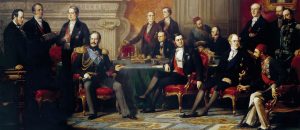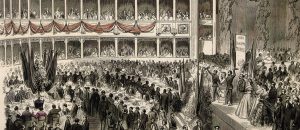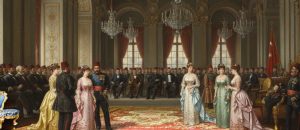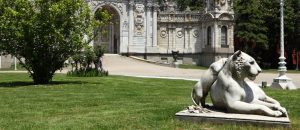The hundreds of silver writing sets, inkwell sets (hokka seti), and crystal reed pens (divit) found in the Dolmabahçe Palace collection are not merely elegant desk accessories, but also the most concrete evidence of the Ottoman State’s transition from a traditional governance based on oral culture to a modern bureaucracy rooted in written culture and archival practices. The increase in the number and quality of these objects indicates the rising correspondence traffic in the palace and the Sublime Porte (Bâb-ı Âli), the standardization of document language, and the fact that decisions were now being made not only through firmans but also through detailed reports, minutes, and legal texts. Together with the changing libraries of the Sultans, this collection proves that Dolmabahçe was not merely a residence but also the “writing room” and administrative center of a modern state. [Link: Dolmabahçe Palace Collections -> /explore/palace-collections]
Transition from Oral Culture to Written Culture
In classical Ottoman administration, the Sultan’s “firman” or verbal command (şifahi emir) was the law itself. Decisions were made through deliberations in the Imperial Council (Divan-ı Hümayun) and the Sultan’s final approval. Writing was certainly important, but the process relied more on personal relationships and oral communication. The Tanzimat reforms fundamentally changed this structure. Newly established ministries (nazırlıklar), councils, and courts required every decision to be based on a written document, a legislative article, or a regulation. This situation led to a massive “document explosion” (evrak patlaması) within the state. Everything now needed to be written down, filed, numbered, and archived. [Link: The rise of Bâb-ı Âli bureaucracy -> /padisahin-kulu-degil-devletin-mimari-dolmahçe-doneminde-sadrazamlik-nasil-saraydan-guclu-hale-geldi] was the engine of this written culture revolution.
Writing Sets: The Status Symbol of the New Bureaucrat
The luxurious writing sets, often inlaid with silver or mother-of-pearl, imported from Europe or made by local craftsmen, which adorned the desks in Dolmabahçe Palace and the mansions of the pashas of the period, reflect the spirit of this new era.
Increased Importance: The quality and richness of a writing set became an indicator of the owner’s place in the bureaucratic hierarchy and their intellectual status. The pen was now a symbol of power as important as the sword.
Standardization: These sets generally consisted of standard pieces such as an inkwell (hokka/mürekkep şişesi), a reed pen (divit/kalem), drying powder (rihdan), a pencil sharpener (kalemtıraş), and a letter opener. This indicates that the act of writing itself achieved a ritual and a standard.
The Role of the Mabeyn: [Link: The Imperial Mabeyn (Mabeyn-i Hümayun) -> /padisahin-hafizasi-mabeyn-katipleri-burokrasi-ile-saray-siyasetini-nasil-birlestirdi], especially the Sultan’s private secretariat, was the center of this written culture. The writing sets used by the scribes (kâtipler) working there were among the most elegant and valuable objects in the palace. The fate of the Empire rested on the tips of the reed pens dipped into these inkwells.
Changing Libraries: From Religious Texts to Encyclopedias
This change in administrative language can also be seen in the library collections, reflecting the shift in the intellectual interests of the Sultans and the palace elite.
Topkapı Palace Library: It mainly focused on classical Islamic and Ottoman sciences such as religious texts (commentaries on the Quran, hadith books), history, geography, and classical Ottoman literature (divan edebiyatı).
Dolmabahçe and Yıldız Palace Libraries: In addition to these classical works, thousands of new books from the West were added to the collections. The personal library of Sultan Abdulhamid II, in particular, is the most striking example of this change. His library contained; French encyclopedias (including Diderot’s famous Encyclopédie), works written on European history, law, and economics, books on modern science (medicine, chemistry, engineering), even [Link: detective novels like Sherlock Holmes -> /marangoz-hunkar-sultan-ii-abdulhamidin-saraydaki-atolyesi-ve-polisiye-roman-tutkusu]. This was proof that the Sultan was now obliged to be equipped not only with traditional sciences but also with the knowledge of the modern world. The library had ceased to be just a treasure but had also become a center for knowledge and reference consulted for governing a modern state.
Conclusion
In conclusion, Dolmabahçe Palace’s writing sets and changing library collections are silent yet powerful witnesses to the profound bureaucratic and intellectual revolution the Ottoman Empire underwent. While silver inkwells (hokkalar) and reed pens (divitler) symbolize the increasing correspondence traffic and the reliance on written documents for decisions, the encyclopedias and Western works in the libraries show that the administrative mind was now nourished not only by tradition but also by modern knowledge. These collections are the clearest evidence that Dolmabahçe was not merely a living space but also an administrative center where a modern bureaucracy and a new intellectual world emerged.
















